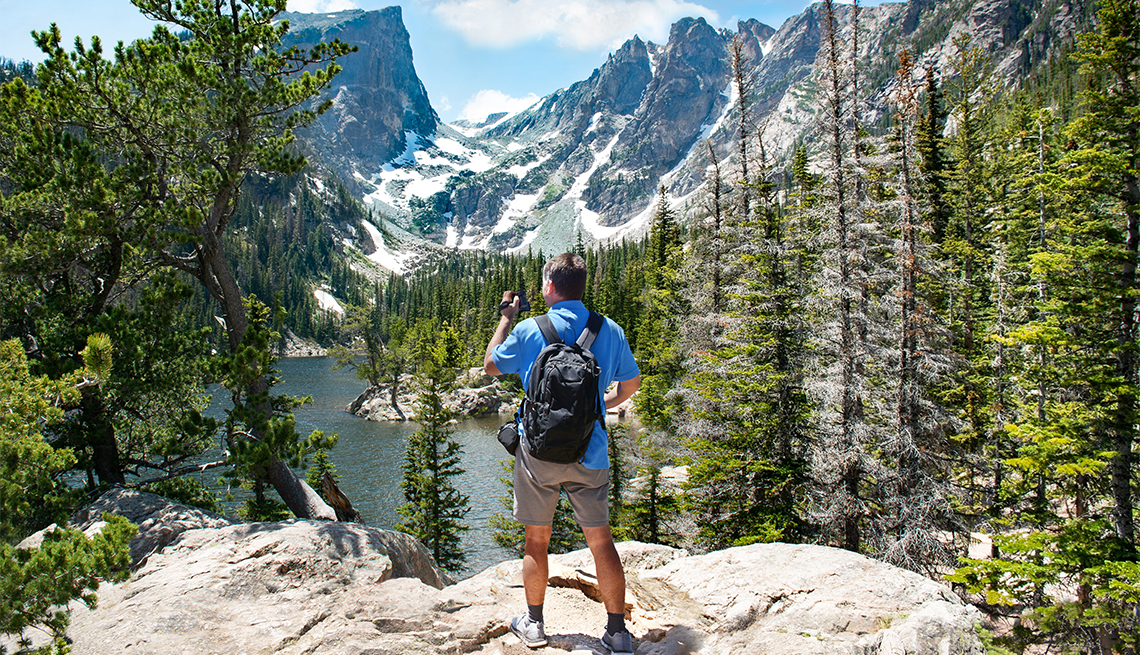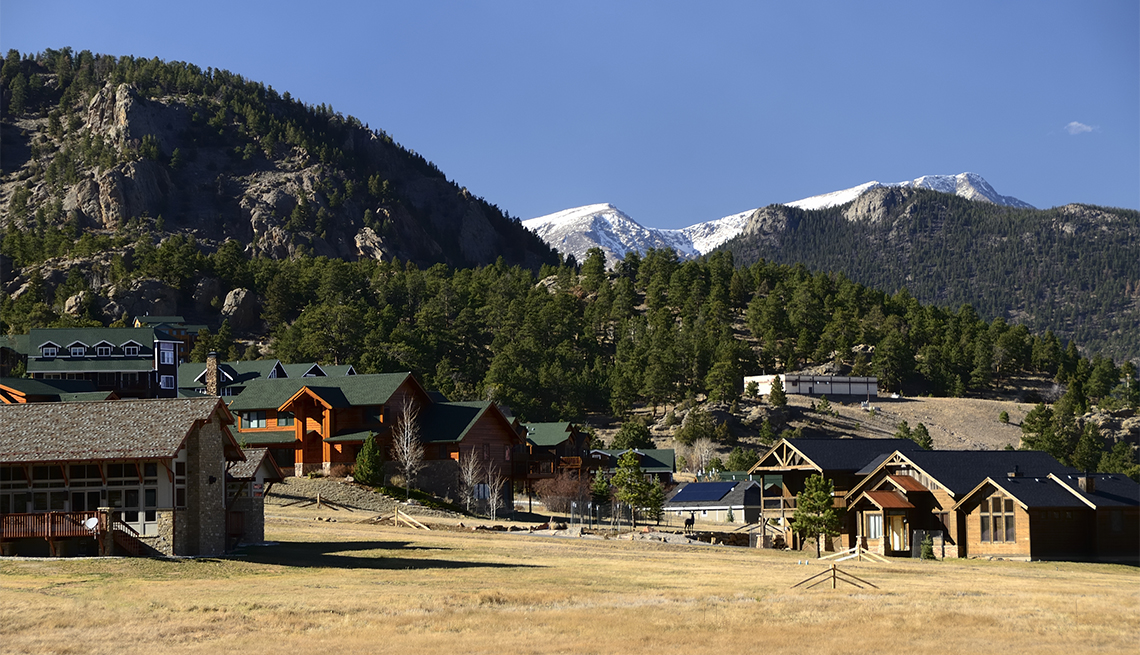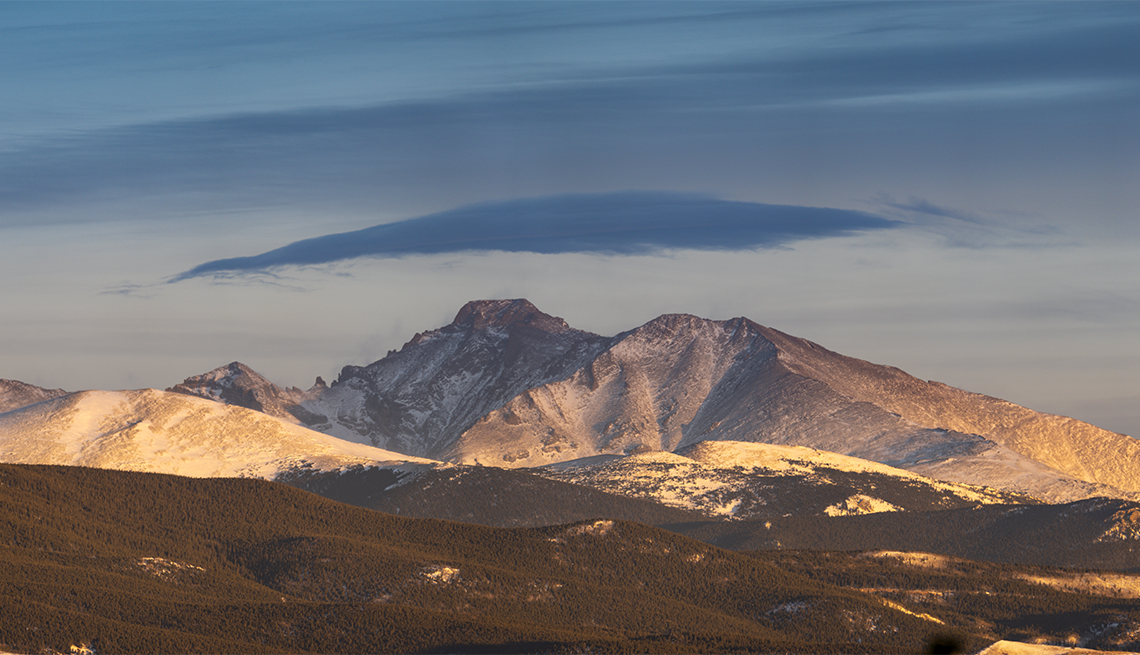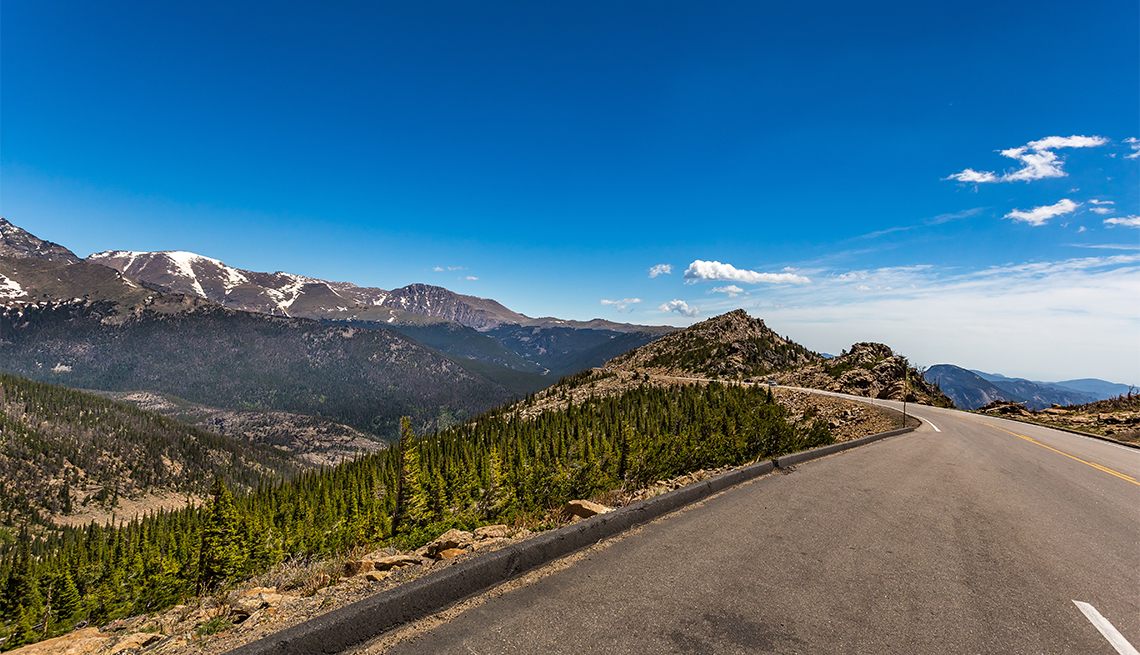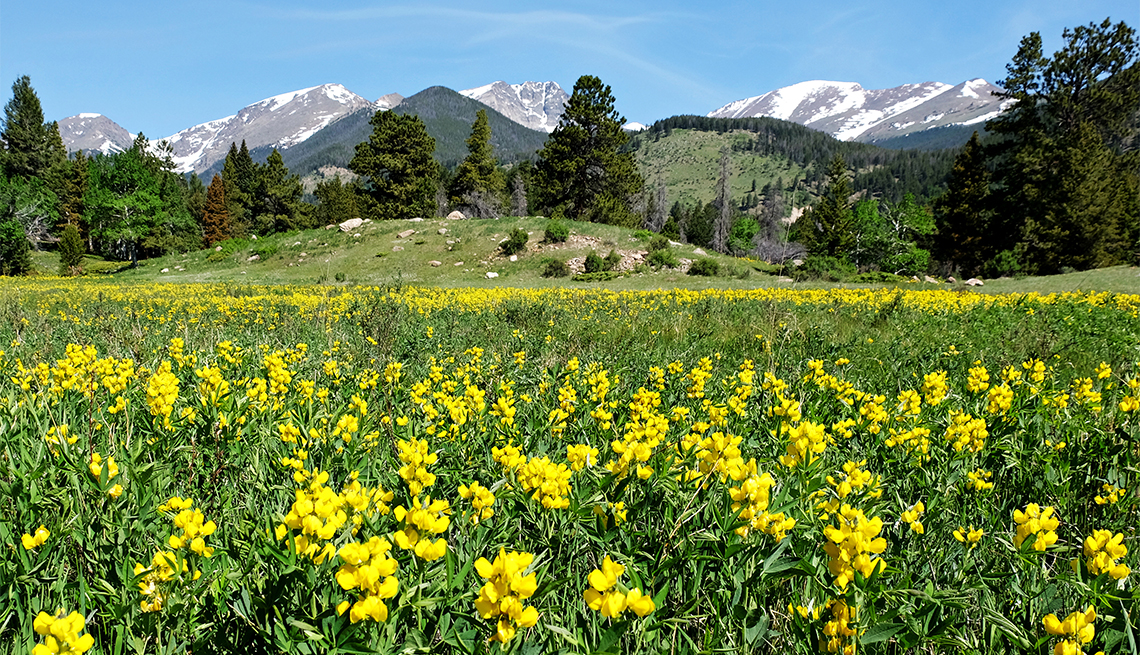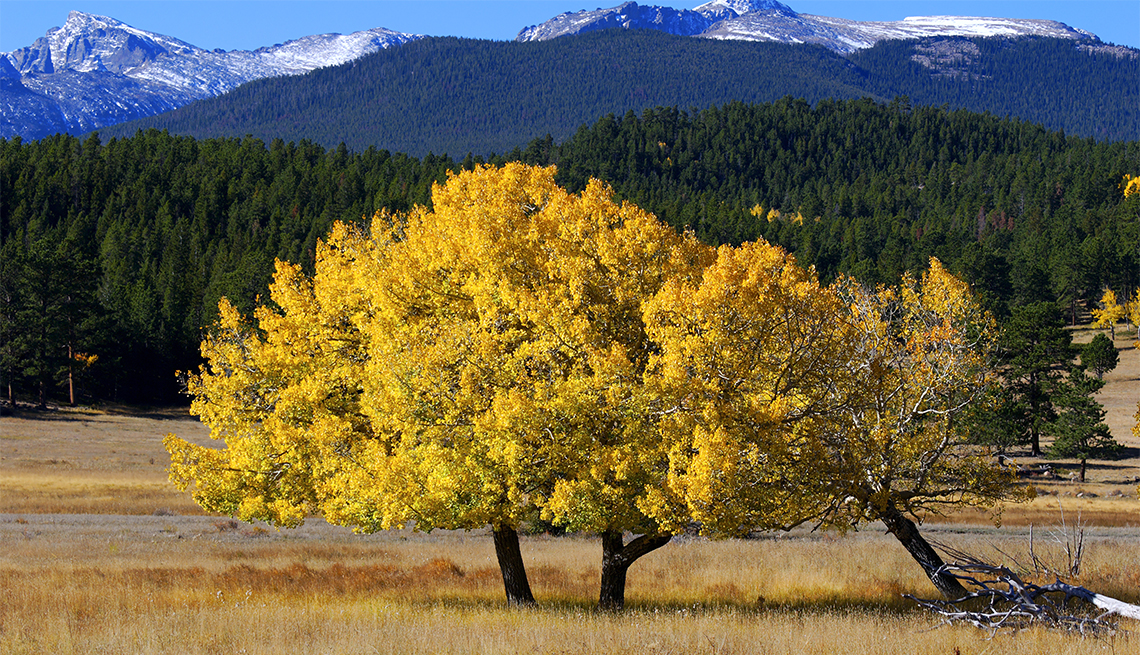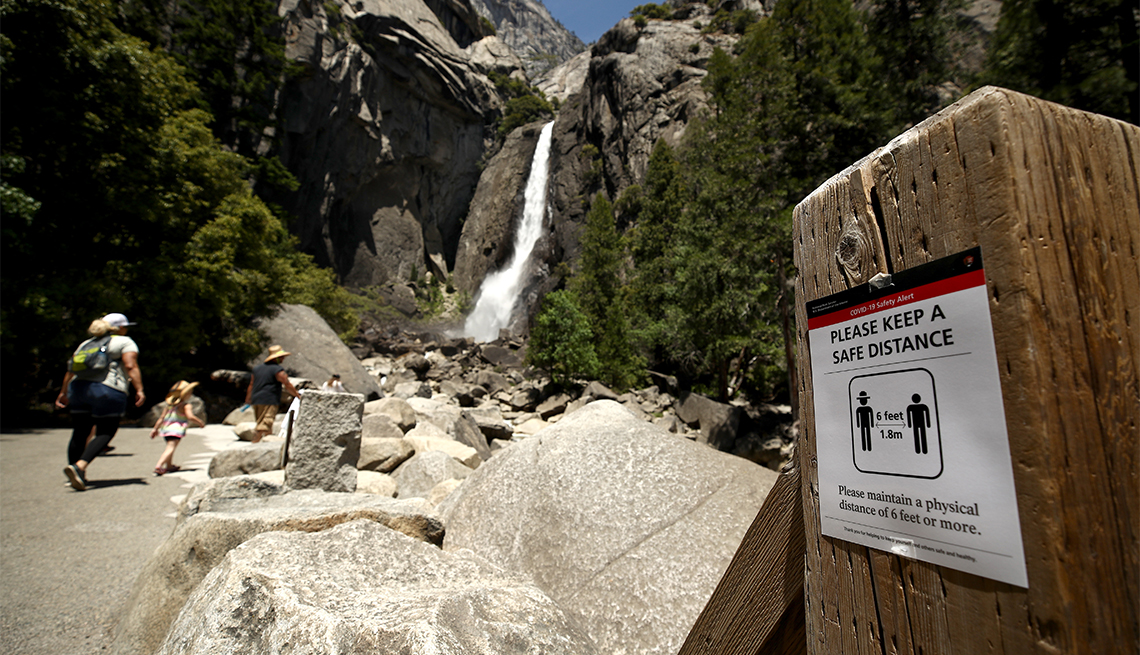AARP's Guide to Rocky Mountain National Park
A Colorado gem sparkles with the richness of wildlife and nature
En español | Even by Colorado standards, Rocky Mountain National Park boasts an embarrassment of riches. Within the park's 265,769 acres, you'll find 150 lakes, 450 miles of streams, over 160 trails and more than 100 peaks rising above 11,000 feet. Alpine tundra, cascading waterfalls and ponderosa pine forests create a breathtaking backdrop for year-round adventures. One of America's premier wildlife viewing destinations, the park is home to bighorn sheep, black bears, bobcats, coyotes, eagles, elk, hawks, moose and mule deer.
Yet for such a wild place, RMNP is quite accessible, just a 67-mile drive northwest from Denver. In 2019, the park hosted more than 4.7 million visitors, making it the country's third-most-visited national park. But don't worry about crowds. With proper planning, you can still find pockets of solitude.
Established in 1915, the park famously straddles the Continental Divide. Its elevations and habitats offer a wide range of opportunities for visitors of all abilities, from easy nature hikes around crystal-clear mountain lakes to challenging scrambles to the 14,259-foot summit of legendary “14er,” Longs Peak. By far, hiking ranks as the most popular activity, but visitors of all ages and fitness levels also come to bike, fly-fish and rock climb — and in winter, they can Nordic ski, snowshoe and sled. Complimentary ranger-led programs focus on astronomy, conservation and history.
While nearly one-third of the park is above tree line, or higher than 11,400 feet in elevation, you don't have to hike to the best views. You can access vistas by horseback or by car, with Trail Ridge Road being a bucket-list driving route. Known as a “scenic wonder road of the world,“ it traverses 48 miles between Estes Park on the park's east side and Grand Lake on the west, taking in several not-to-be-missed sights.
Location: north-central Colorado
Acreage: 265,769
Miles of trails: More than 355 miles along about 160 trails
Main attraction: Longs Peak, one of Colorado's most popular 14ers
Entry fee: $25 for a vehicle day pass, plus $2 fee per reservation. $20 for an annual Senior Pass (62+).
Best way to see it: On foot or in a car via Trail Ridge Road, the highest continuously paved highway in America
When to go to avoid the crowds: Winter
Handicap accessible: Very
Plan Your Trip to Rocky Mountain National Park
Access the park through four entrances, three on the its east side, near Estes Park, and one on the west, near Grand Lake. Some of Colorado's coolest mountain towns, including Boulder, Fort Collins and Lyons, are less than a two-hour drive from the east entrances. If you're flying in and renting a car, Denver International Airport is a quick 90-minute drive via toll road E-470 northwest and Highway 36. For more scenery and just 20 minutes of extra driving, take Highway 7 rather than Highway 36.
Nearly 80 percent of visitors access the park from the east side. The 20 percent who come through the west entrance, Fall River, come via Grand Lake or Granby, and most take Trail Ridge Road (U.S. Highway 34). The highest continuously paved road in the U.S. is known appropriately as the “Highway to the Sky,” as it crosses the Continental Divide at 12,183 feet. The road usually opens Memorial Day weekend; snow forces its closure by early to mid-October. A traffic-free alternative is the one-way-only Old Fall River Road. Open mid-July to mid-October, this dirt road evokes nostalgic national park vibes and features plenty of waterfalls, wildlife and spectacular Fall River Valley views while delivering you to the top of Trail Ridge.
Open year-round, RMNP has something unique to offer every season. Summer and fall weekends are the busiest. Wildflower season spans June and July, when brilliant blooms carpet the meadows and hillsides. Come autumn, the backdrop glows pure gold as the aspen trees turn. September through October is elk mating season, otherwise known as “the rut.” Marvel at the sound of bull elk bugling and the site of antler-locked bulls doing battle to attract cows. Spring can be a gamble, with either muddy or snowy conditions based on the winter season. Crowds disappear when snow covers the park. Explore the trails by snowshoe or on cross-country skis or grab a toboggan and go sledding at Hidden Valley, the only place in the park that allows sledding. The park does not rent equipment, but rental shops, such as Estes Park Mountain Shop, are plentiful in gateway towns. Winter is also a prime time to spot wildlife, including elk, moose and mule deer. Some of the best viewing spots include Bear Lake Road, the Fall River entrance to the park and Moraine Park. Animals tend to be more active at dawn and dusk. Note: Social distancing applies to wildlife, too. Park rules mandate you must stay 75 feet from them.
The park's seven visitor centers have restrooms, and the Beaver Meadows and Fall River centers offer free Wi-Fi. Otherwise, expect vaulted, outhouse-style toilet facilities scattered throughout the park at campsites and trailheads and extremely limited Wi-Fi and cellular service. “We urge people to plan ahead,” says Rocky Mountain National Park spokesperson Kyle Patterson. “We don't have trail books to sign in and out so no one will come looking for you. It's important to let someone know where you are going and when you can expect to come back. We highly encourage visitors not to hike alone."
With more than 160 trails, many would argue that RMNP is best experienced on foot. Plentiful scenic outlooks serve as rest stops and there are trail options for all fitness levels. With the park's base elevation of 7,800, most out-of-towners will need to acclimate. Staying hydrated, even in winter, is crucial in order to avoid altitude sickness. “Altitude does not discriminate,” says Patterson. “It affects all user groups — young, old, athletic — and can aggravate preexisting health conditions. You can visit and feel fine and return the following year and have a different experience.” Signs of altitude sickness include shortness of breath, fatigue, headaches and nausea. If you experience these symptoms, let someone know and seek medical attention, she says. Drinking water throughout the day and avoiding alcohol can help minimize the effects of altitude. According to Patterson, the park does not categorize trails as easy or difficult because of the altitude. “We urge people to look at distance and elevation gain,” she says. “Start easy, listen to your body and gradually increase the distance and elevation gain of your hikes.”
AARP Membership -Join AARP for just $12 for your first year when you enroll in automatic renewal
Join today and save 25% off the standard annual rate. Get instant access to discounts, programs, services, and the information you need to benefit every area of your life.
If you're coming from sea level, driving through the park on the first day might be a smart idea, says Patterson. “The number one reason people visit the park is for the scenic beauty and you don't need to hike to appreciate it,” she says. Some of the best views can be appreciated from your car window via Bear Lake Road, Old Fall River Road and Trail Ridge Road. If you're looking for a super scenic drive from Denver that takes in the park wilderness plus some of the state's top mountain towns, consider the Rocky Mountain National Park Scenic Loop. Not actually a loop, the four-hour drive covers 164 miles of dreamy vistas, starting with the 90 minute drive from Denver to Estes Park through Boulder. Then follow RMNP’s Trail Ridge Road through Grand Lake and Granby to Winter Park.
Things to Do in Rocky Mountain National Park
With more than 355 miles of trails, RMNP is a hiking mecca. While the park is best known for its steep terrain, accessible trails have been constructed in particularly scenic areas. Visitors who are adjusting to the altitude, have visual impairments or who prefer level, smooth paths should explore Lily Lake, just south of Estes Park, or the Coyote Valley Trail, on the park's west side; two of its four wheelchair-accessible trails. Nearly 80 percent of the trail network is also open to horseback riding. Sombrero Stables offers guided rides and has a location in Estes Park and two stables within the park at Glacier Creek and Moraine Park, both on the east side. In winter, traverse the trails on cross-country skis or snowshoes, or sled in the designated area. Other possibilities include fly-fishing, rock climbing, stargazing and wildlife viewing. Here are some not-to-be-missed highlights.
Drive Trail Ridge Road
Devote an entire day to driving one of America's most magnificent scenic byways. Bighorn sheep, marmots and rock ptarmigans frequent the meadows and crags, so keep a sharp eye out. Be sure to stop along the Continental Divide. Experienced and acclimated hikers can park at Milner Pass and hike 4.5 miles along the Continental Divide to the summit of Mount Ida at 12,880 feet. Of the road's many scenic overlooks, Many Parks Curve is a must stop. The name refers to its vistas of Estes Park, Horseshoe Park and Moraine Park. You'll also see the snowcapped peaks of Mount Lady Washington, Mount Meeker and RMNP's crown jewel, Longs Peak. From the Alpine Visitor Center, a quarter-mile-long paved path gains 200-some feet of elevation and delivers lovely alpine views. Rainbow Curve pullout has vault toilets and from the curve you can spot a handful of 13ers, including Hagues Peak and Mummy Mountain.
Tackle Longs Peak
Only experienced hikers should attempt a summit of this prominent Front Range landmark. You'll want to build up your endurance at altitude, as the 14.2-mile out-and-back climb takes from 10 to 15 hours and requires some serious scrambling at the top. The reward: views of Black Lake, Glacier Gorge and Powell Peak. One of Colorado's most attempted 14er summits, Longs is prone to trail congestion. The Keyhole Route is the classic way up, but Longs’ has more than 120 other route options. Colorado Mountain School, one of the few outfitters allowed to guide inside the park, offers one-day trips.
Hike to a waterfall
RMNP boasts more than 30 waterfalls, many reachable on foot. “We remind people that rocks are slippery, so if you want to get close to the water, move with caution,” Patterson says. “There are plenty of lookouts but our park doesn't have benches. You'll be admiring the views while leaning on a tree or sitting on a rock."
Adams Falls, a 55-foot-tall series of cascades that flow down a jagged cliffside overlooking movie-worthy mountain scenery, is one of the easiest to reach, just a 0.45-mile trek via the East Inlet trailhead near the town of Grand Lake on the park's west side. This also makes it one of the most visited falls, attracting more than 110,000 hikers a year.
A less crowded, equally mellow alternative on the park's east side is Alberta Falls. Accessed by the Glacier Gorge trailhead, this hike winds 0.85-mile through aspen groves and pine forests, depositing visitors at the 30-foot chute that spills down a gorge.
Located in the park's southeast corner, Ouzel Falls requires a bit more effort. Reached by the Wild Basin trailhead, the 5.4-mile round-trip hike passes a handful of other waterfalls before reaching Ouzel, a 40-foot gusher. For roaring waters, visit during the spring snow runoff.
Fly-fish for trout
An angler's paradise, RMNP has countless options for casting, from wild alpine lakes to easy-to-access streams. Big Thompson River, near Estes Park, has some of the most trafficked waters in the summer, so explore sections of the river farther from the road to find larger, less spooked fish. Located in the park's Glacier Gorge area, Sprague Lake and the Loch are well stocked with brook and greenback cutthroat trout. In the park's southeast corner, Thunder Lake boasts one of RMNP'S most bountiful trout stocks along with dreamy views of Mount Alice, Pilot Mountain and Tanima Peak. Important note: you need a valid Colorado fishing license to fish in the park, which you can obtain from the Colorado Division of Parks and Wildlife website. Book a guide or stock up on equipment at Kirks Fly Shop or Estes Anglers, both in Estes Park.
Trek around a lake
RMNP is often referred to as the land of lakes given its multitude of sparkling blue-green waters. With negligible elevation gain, the Bear Lake Loop is one of the park's four wheelchair-accessible paths. Located in the heart of the park, this informative, 0.6-mile interpretive nature trail is 9.5 miles from the Beaver Meadows Visitor Center. During peak summer season the trailhead's parking lot fills quickly. Arrive early or plan to use the free shuttle from the visitor center to reach the trailhead.
If you want a workout, drive 10 miles south of Estes Park and head to Chasm Lake via the Longs Peak trailhead. The 8.4-mile, round-trip trek is a quad burner but the deep-green pool and views of the east-facing wall of Longs Peak, known as the Diamond, are well worth the effort.
Dream Lake is an easy 2.2.-mile, out-and-back hike that begins at Bear Lake trailhead, just outside of Estes Park, and passes Nymph Lake en route. Rise early to arrive by sunrise and watch the waters take on a heavenly pink glow.
Gateway Towns to Rocky Mountain National Park
Estes Park
A destination in its own right, Estes Park feels more like a base camp where you can stay and play. Bordering RMNP'S eastern edge, the town is less than a 10-minute drive from the Beaver Meadow Visitor Center and Fall River Visitor Center entrances and a half-hour from the Wild Basin entrance. It's also surrounded by less crowded, non-park wilderness spaces, including Roosevelt and Hermit Open Space. Both are dog-friendly and allow recreational opportunities that are off-limits in a national park, such as mountain biking, off-roading and non-permit wilderness camping. The easy, 3.6-mile round-trip Kruger Rock Trail in Hermit Park Open Space rewards hikers with incredible views over Estes Valley and into the national park. For off-roading fun, Estes Park-based Wildside 4x4 Tours offers guided trips that explore the beauty of Roosevelt National Forest.
Camping is a quintessential Estes Park activity, so reserve sites in advance. The town has a handful of well-appointed sites, including a KOA Campground suitable for small RVs and Yogi Bear's Jellystone Park Camp-Resort, which has cabins, RV and camp sites, a heated pool and mini golf. If you're not up for roughing it, splurge on a stay at the historic 140-room Stanley Hotel. The muse for the Stephen King thriller The Shining, the Colonial Revival landmark was originally built by Freelan Oscar Stanley, an East Coast entrepreneur seeking a healthier life in the Rockies. Stanley is largely credited with developing Estes Park into a proper town with civic organizations, a power plant and waterworks.
Today, you'll find four breweries, a winery and a distillery plus charming mom-and-pop shops. Burgers, bourbon and portobello fries are the hits at Bird and Jim, a restaurant where local climbing legend Tommy Caldwell often hangs out. For a fast-casual, post-hike bite, grab an elk kebab from Himalayan Curry & Kebob. At night, the Rock Inn Mountain Tavern is known for its live music and comfort foods such as bison meatballs.
Many visitors plan their trips around annual events such as Jazz Fest (June), Rooftop Rodeo (July) and Bigfoot Days (April), a celebration of Sasquatch lore.
Grand Lake
RMNP's western gateway, Grand Lake is more mountain hamlet than town. This sleepy community of about 500 year-round residents comes to life in summer months when vacationers flock here to take advantage of Colorado's largest and deepest body of water, Grand Lake. First-come, first-served Elk Creek Campground offers views of RMNP plus amenities including picnic tables, fire pits, showers and bathrooms, and a recreation room with Wi-Fi. For a splurge, book one of the 70 recently renovated cabins at Grand Lake Lodge. Grand Lake Marina rents motorboats and paddle sports equipment, including canoes, kayaks and stand up paddleboards.
For such a small town, you'll find a surprising number of dining options. The bagel sandwiches and breakfast burritos at Blue Water Bakery will fuel you through the day. Western-themed Sagebrush BBQ & Grill is known for its pork ribs and corn bread. There's no shortage of ice cream shops in Grand Lake, but the homemade scoops from shorefront Miyauchi's Snack Bar are worth seeking out.
- |
- Photos
Freelance writer and editor Jen Murphy contributes to a variety of publications, including Condé Nast Traveler, Outside, Travel + Leisure and The Wall Street Journal.
Editor's note: This article was originally published on July 17, 2020. It's been updated to reflect recent COVID-19 developments.



